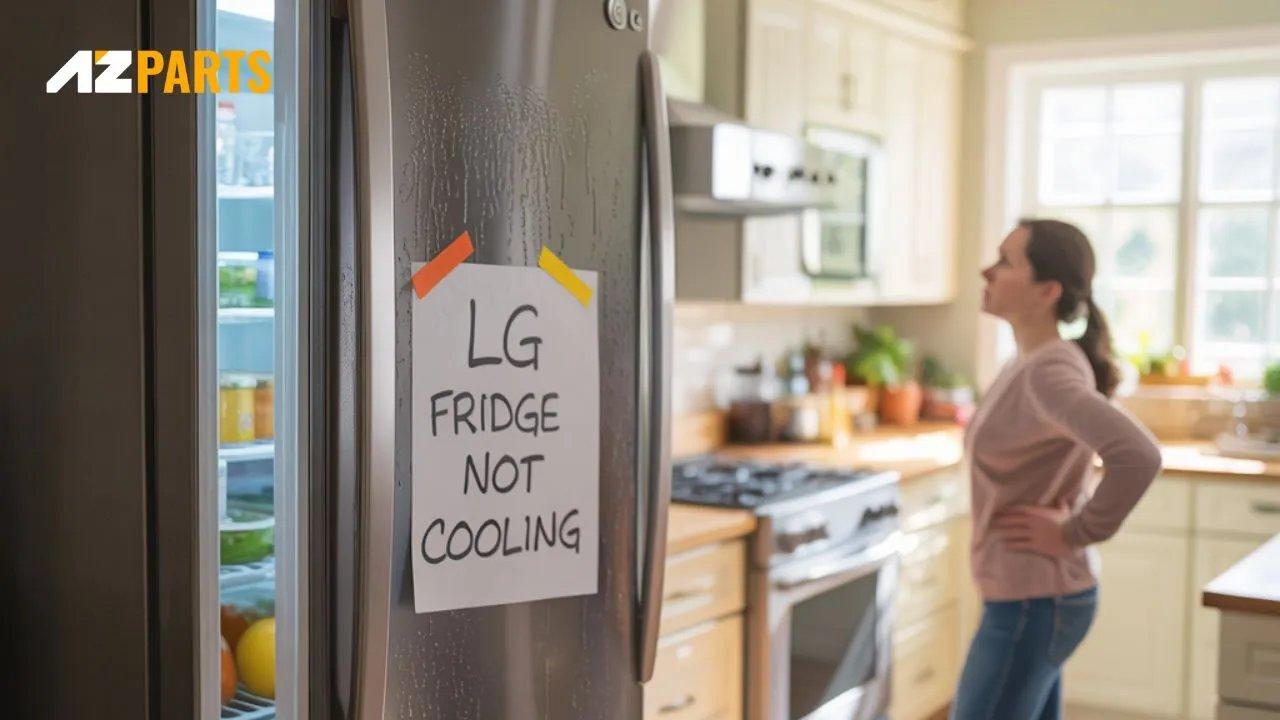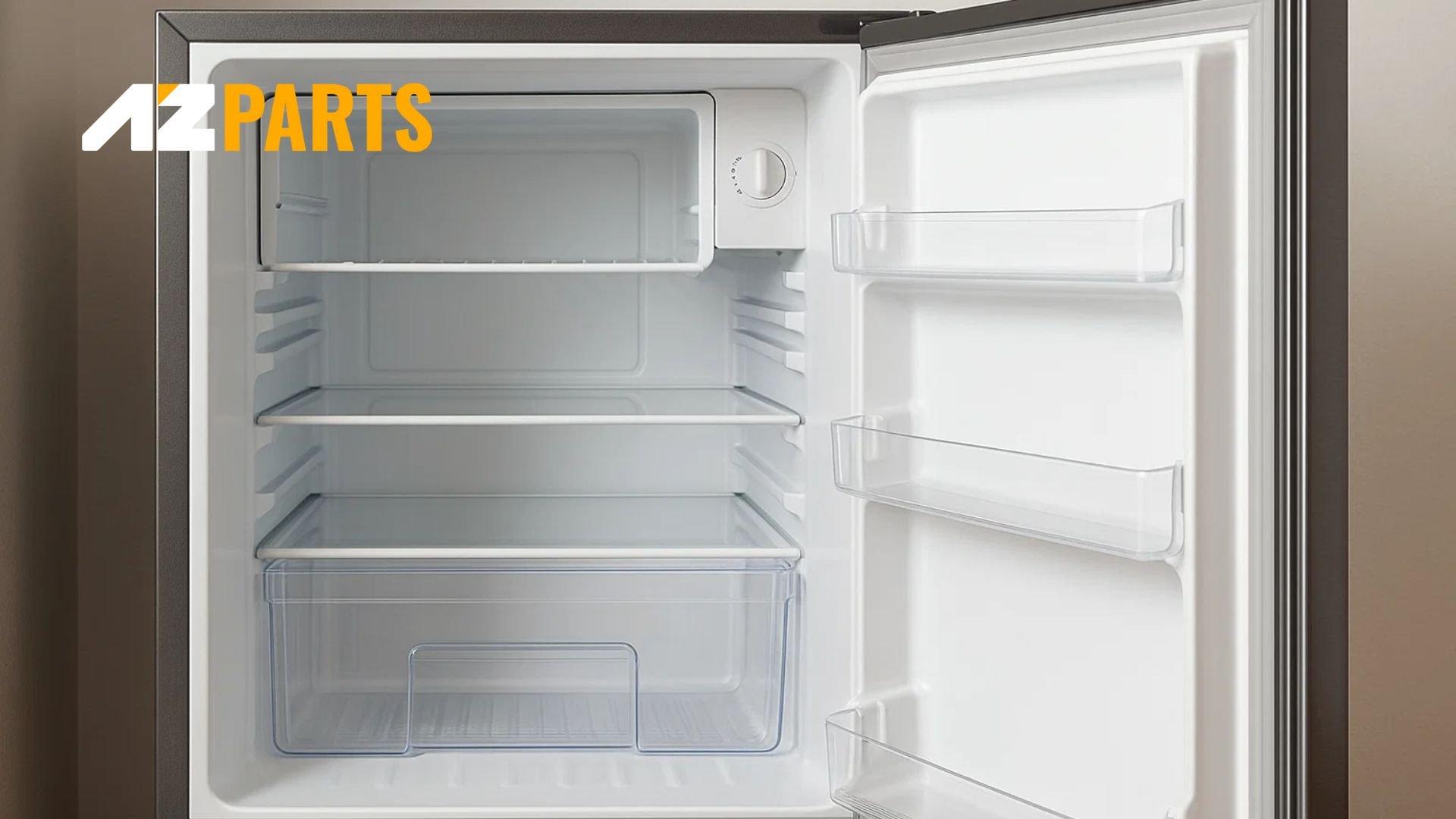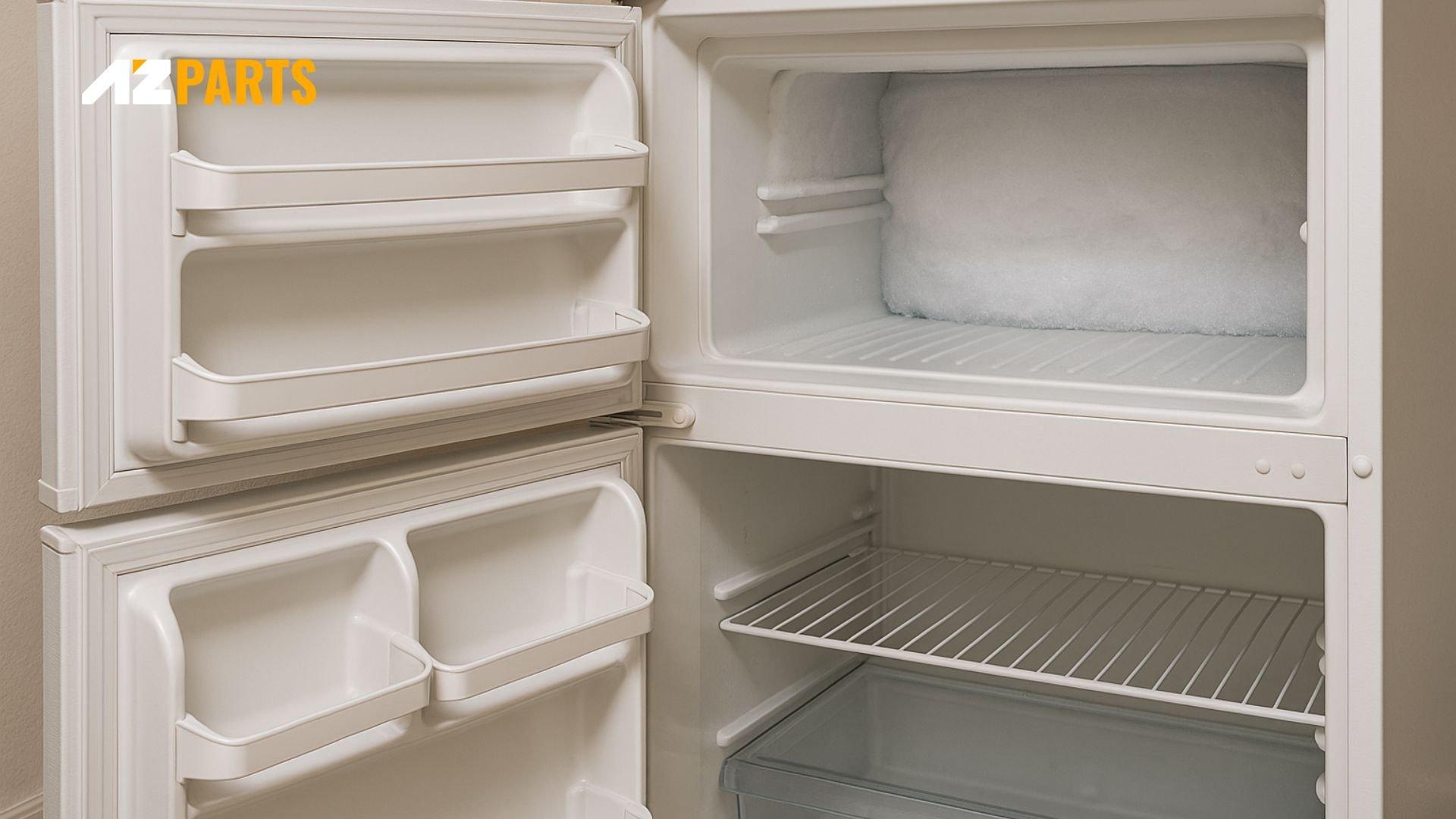Repair help
Whirlpool Refrigerator Problems: Easy and Quick Fixes
AZparts Team
Updated on July 30, 2025
14 min read
Whirlpool refrigerators are built to last, but even the best appliances can face occasional hiccups, whether it’s weak cooling, odd noises, or power glitches. If your fridge is falling short, don’t panic. AZParts will guide you through the most common Whirlpool refrigerator problems and offer reliable parts and expert tips to restore smooth operation right from your home.

1. Whirlpool Refrigerator Not Cooling Properly
Why It Happens:
Before doing anything, check if there was a recent power outage or if you added a large amount of food. Both can cause the temperature to rise for a while. In these cases, it may take several hours for the fridge to cool down again. If the refrigerator was just installed, give it up to 24 hours to reach the proper temperature.
Apart from this, the issue may be caused by:
- Dirty condenser coils that prevent heat from dissipating
- A faulty condenser or evaporator fan motor disrupting airflow
- A failed thermostat, start relay, or capacitor preventing the compressor from starting
- In rare cases, a faulty control board or compressor
How to fix:
- Wait 24 hours after installation or power restoration. Keep doors closed and avoid overloading with warm food.
- Check that cooling is turned on and Demo Mode is off. Set the fridge to 37°F (3°C) and freezer to 0°F (-18°C).
- Ensure vents aren’t blocked by food items. Unplug the unit and clean the condenser coils.
- If airflow is weak or noisy, inspect fan motors and replace Whirlpool refrigerator motors if necessary.
- Use a multimeter to test the thermostat, start relay, or capacitor, and replace any faulty parts.
- If basic fixes don’t help, the control board or compressor may require professional repair.
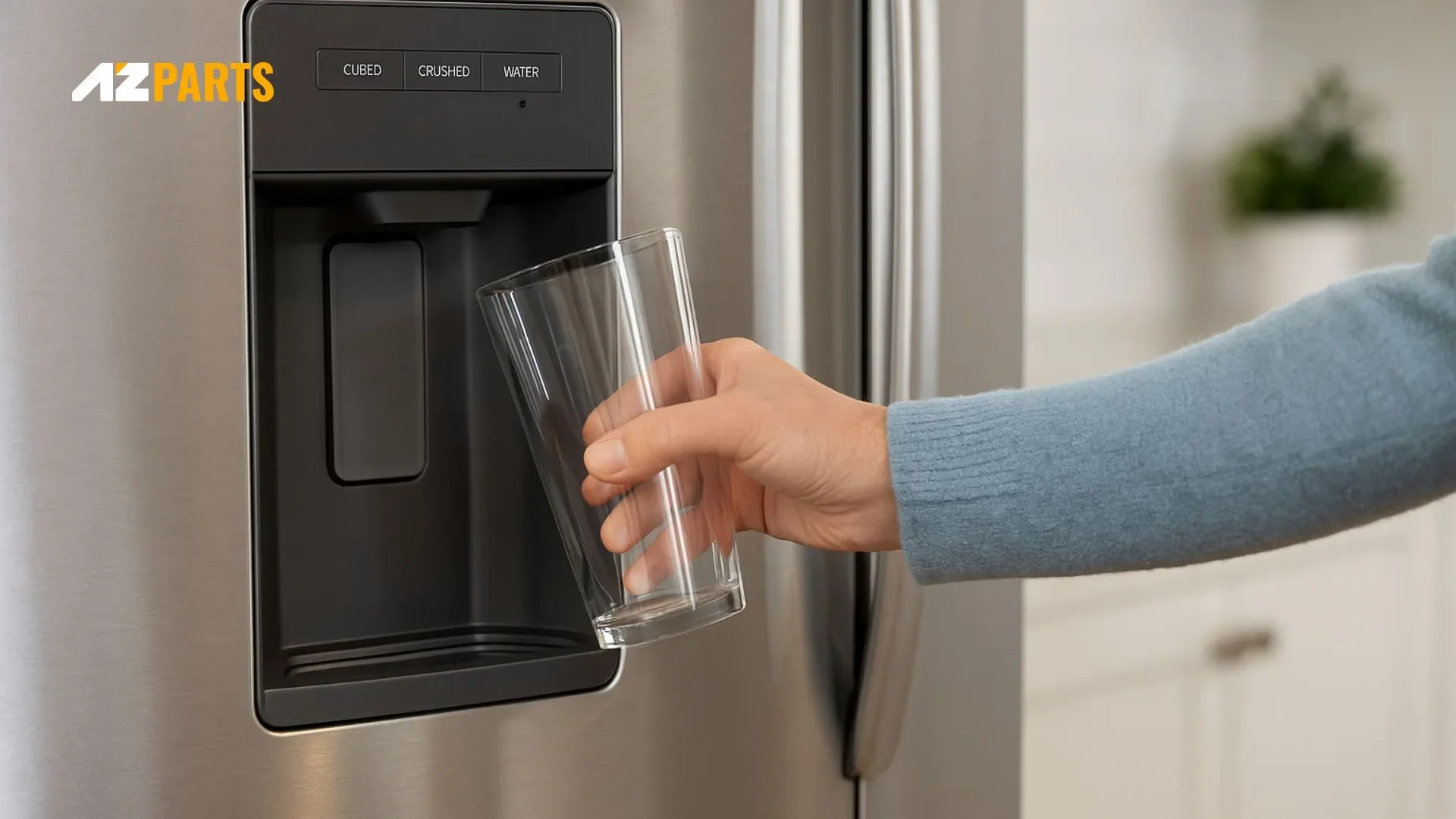
Troubleshooting a Whirlpool Refrigerator Water Dispenser That’s Not Working (source: AZParts)
2. Whirlpool Refrigerator Water Dispenser Not Working
Why It Happens
The most common is a clogged or incorrectly installed water filter, which reduces or blocks flow. Air trapped in the system after installing a new filter can also cause sputtering or slow dispensing.
If the water line is frozen, especially in colder environments, water can’t pass through. Other causes include low water pressure (below 30 psi), a faulty water inlet valve, or a broken door or dispenser switch that prevents the system from activating.
How to fix:
- Remove and reinsert the water filter. Then try dispensing water without the filter—if flow improves, replace it with a new, Whirlpool-approved one.
- Flush the water system after changing the filter by dispensing and discarding 2–3 gallons of water in short bursts. This clears trapped air and helps activate the filter.
- Check your home’s water supply pressure (should be 30–120 psi). Ensure the shutoff valve is fully open and the supply line is not kinked or blocked. If no water dispenses at all, inspect the water inlet valve behind the fridge and test it for continuity; replace it if defective.
- Also test the dispenser switch and door switch with a multimeter. If either fails to register a closed circuit when pressed, replace them.
3. Whirlpool Refrigerator Not Defrosting
Why It Happens: When your refrigerator doesn’t defrost, frost begins to build up on the evaporator coils, blocking airflow and reducing cooling efficiency especially in the fridge compartment.
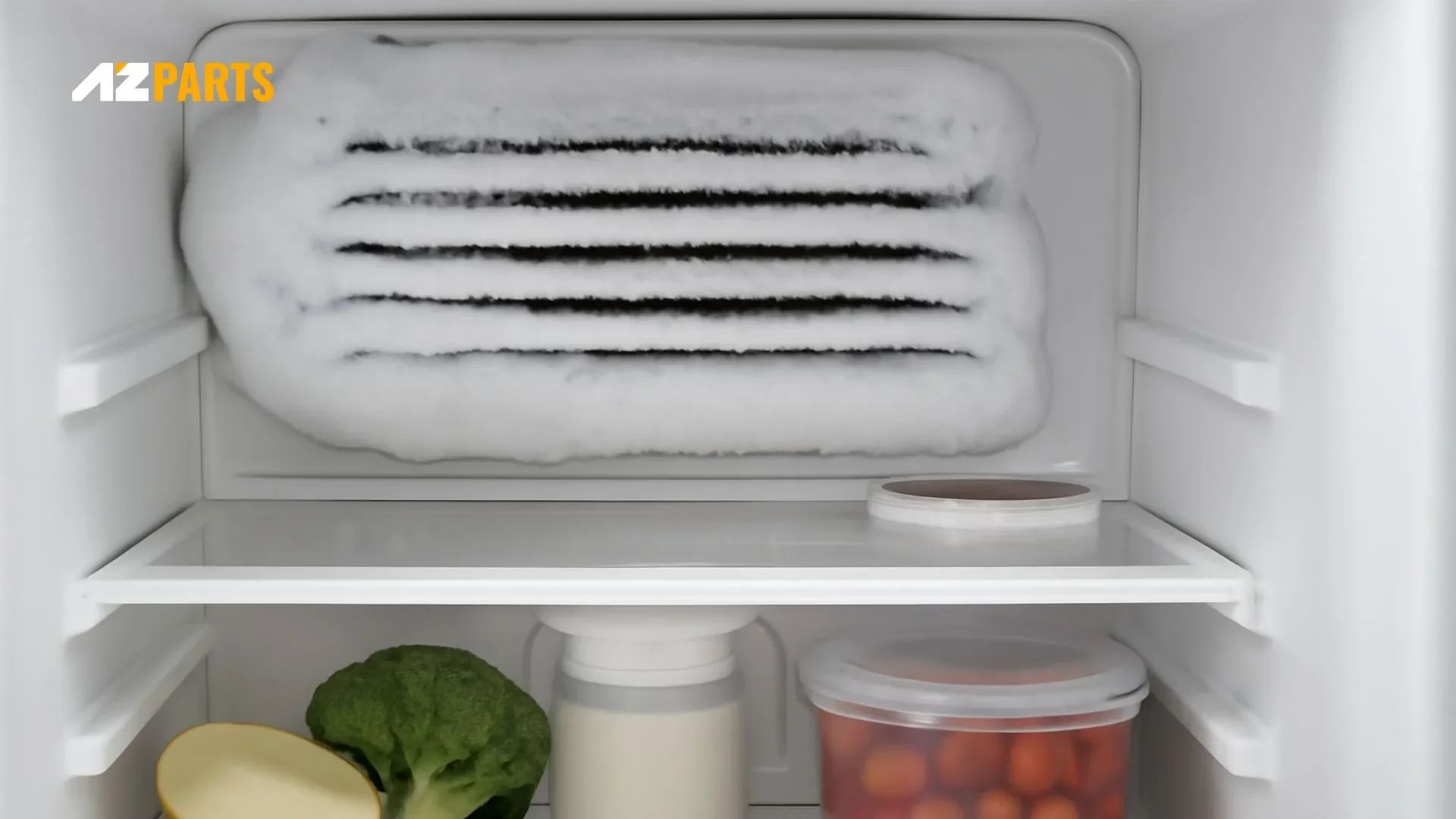
This is typically caused by one of the following component failures:
- A faulty defrost timer that doesn’t activate the defrost cycle
- A bad defrost thermostat that fails to close the circuit for the heater
- A burned-out defrost heater that can’t melt the frost
- A failed defrost control board in newer models that don’t use mechanical timers
- Or simply leaving the door open too long, letting humid air in
Additionally, a damaged door gasket can prevent proper sealing and contribute to frost buildup.
How to fix:
First, unplug the refrigerator. Locate and test the defrost timer (usually behind the control panel or kick plate). Manually advance it—if the defrost heater doesn’t turn on or the timer doesn’t advance on its own, replace the Whirlpool refrigerator timer.
Then test the defrost thermostat for continuity at cold temperatures. If it remains open (no continuity), it needs a Whirlpool refrigerator thermostat.
Inspect the defrost heater near the evaporator coils. Use a multimeter to check for continuity—if it’s burned out, replace it.
If all components above test fine but frost still builds up, the issue likely lies in the electronic defrost control board. Replace it with a compatible part for your model.
Also check for non-electrical causes:
- Ensure doors are closing fully and not left open for extended periods
- Inspect the door gasket for cracks, warping, or debris. Clean or replace if needed
4. Fridge Making Loud Noise
Why It Happens
Unusual noises from your Whirlpool refrigerator can come from multiple sources:
- Grinding, whirring, or squealing may be due to fan blades rubbing against ice or debris, or worn motor bearings.
- Rattling or vibrating typically occurs when the fridge is placed on an uneven surface or has loose parts.
- Clunking or banging during defrost cycles might be normal, but if frequent or loud, it may indicate a compressor issue.
How to fix:
Identify the type and source of the noise:
- For grinding or squealing: Unplug the fridge and inspect the evaporator and condenser fans. Remove any ice, debris, or dust. If clean but still noisy, the motor may need replacement.
- For rattling or vibrating: Use a leveling tool to stabilize the unit. Tighten loose panels or shelves, and remove any objects placed on top.
- For banging or clunking: If rare, it may be normal ice movement during defrost. If frequent and loud from the rear, call a technician to inspect the compressor.
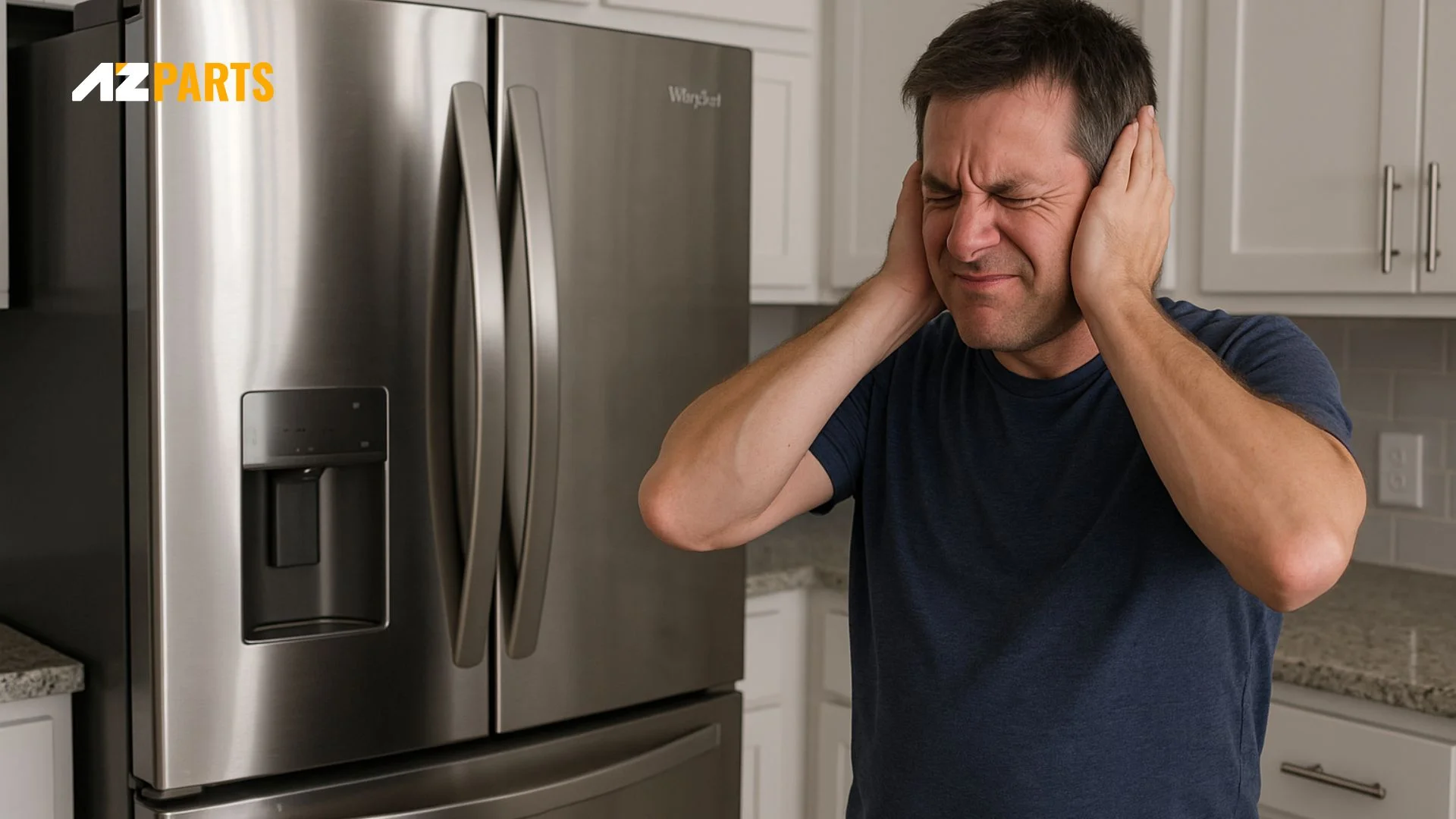
The refrigerator is producing unusually loud noises during operation. (Source: AZParts)
5. Whirlpool Refrigerator Error Codes
Why It Happens
When a Whirlpool refrigerator displays an error code, it’s the system’s way of alerting you to a specific malfunction. These codes are triggered when internal components aren’t working as expected.
The most common causes include:
- Power issues or open doors: Sudden power outages or leaving the door ajar for too long can disrupt internal temperature and trigger alerts.
- Sensor or fan malfunctions: Temperature sensors that misread data or cooling fans that stop working can cause improper cooling and error messages.
- Defrost failures: If the defrost cycle fails, frost may accumulate on evaporator coils, prompting a defrost-related error code.
- Communication errors between control boards: Modern models rely on multiple boards (main control, user interface, etc.). If they fail to communicate due to wiring issues or board faults, the system logs an error.
How to fix:
- E0 / F0 — Power Loss or Door Left Open: Close the door properly and press any button to clear the alert.
- E1 / F1 — Fridge Temperature Sensor Fault: Unplug the unit for 1 minute to reset. Replace the thermistor if the code returns.
- E2 / F2 — Freezer Sensor or Fan Error: Clear ice buildup, check the fan motor and sensor.
- E3 / F3 — Defrost Sensor or Condenser Fan Error: Inspect for obstructions and test related components.
- E4 / F4 — Fridge Defrost Sensor Fault: Replace any defrost parts that fail a continuity test.
- E5 / F5 — Freezer Defrost Sensor or Ice Maker Error: Address frost buildup or replace faulty components.
- E6 / F6 — Communication Error: Restart fridge. Check wiring and control board.
- E7 / F7 — Environmental Sensor Fault: Move unit away from heat. Replace the ambient sensor.
- E8 / F8 — System Error: Likely a compressor or refrigerant issue. Requires technician service.
- E9 / F9 — Freezer High Temperature: Ensure proper sealing. Replace sensor if temperatures don’t normalize.
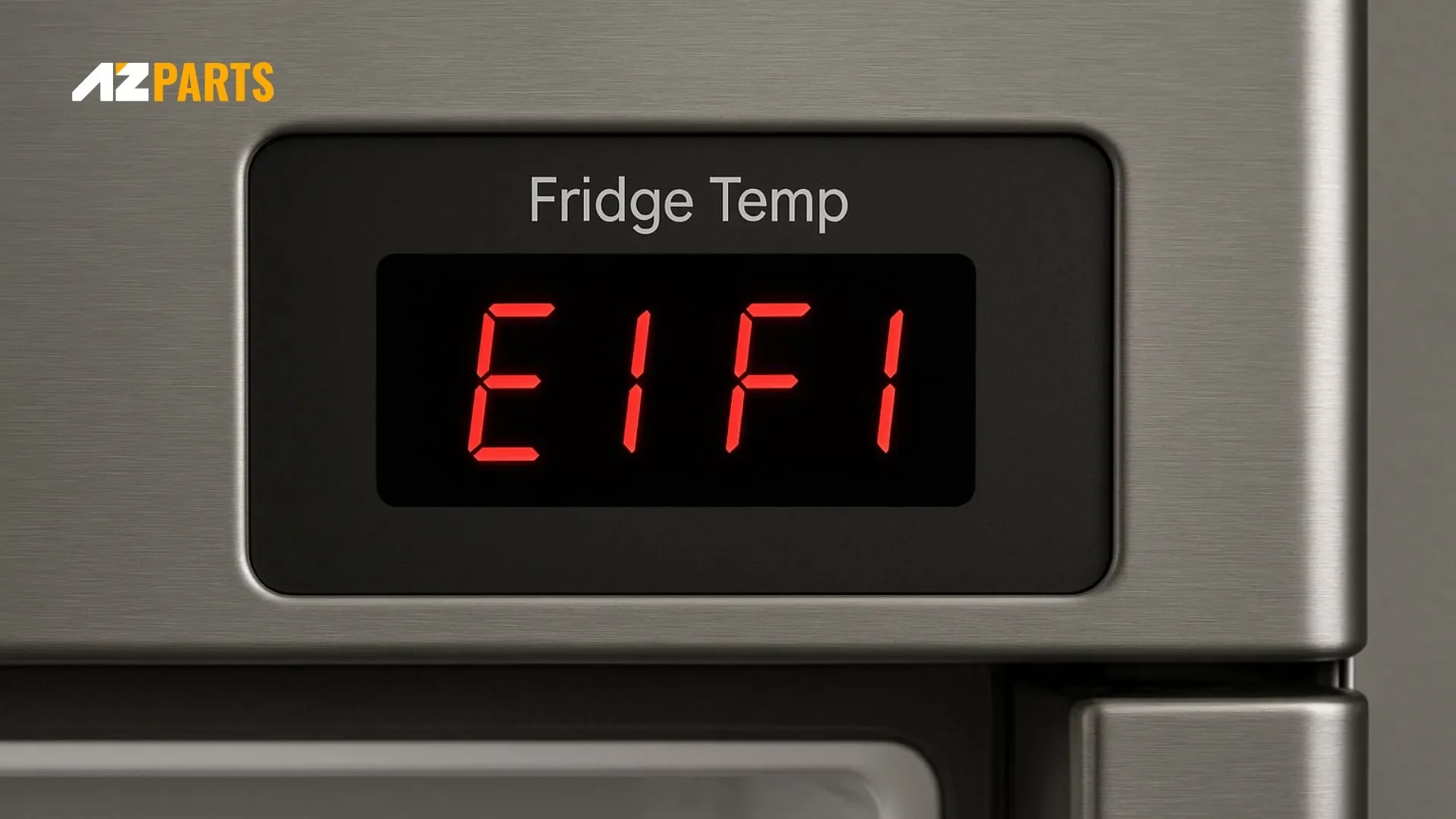
Error codes displayed on Whirlpool refrigerators (Source: AZParts)
6. Whirlpool Refrigerator Light Flickering
Why It Happens
- Loose or failing LED bulb: A bad connection or internal failure causes intermittent lighting.
- Faulty light module or LED board: These parts may degrade over time or short out.
- Inconsistent power supply: Voltage fluctuations can affect lighting.
- Defective door switch: If the door switch doesn’t detect the door properly, the light may flicker.
How to fix:
- Tighten or replace the LED bulb: A loose or faulty bulb is a common cause. Secure it or install a compatible replacement.
- Replace the light module: If tightening the bulb doesn’t help, the entire light module may be faulty and should be replaced.
- Test and replace the door switch: A malfunctioning door switch can cause flickering. Use a multimeter to check it and replace if needed.
- Call a technician if multiple lights flicker: This could indicate an issue with the control board or power supply. Professional inspection is recommended.
7. Whirlpool Refrigerator Leaking Water
Why It Happens
- Clogged or frozen defrost drain: Water can’t exit the fridge properly during defrost cycles.
- Loose or disconnected water line: Water may leak from the rear of the fridge.
- Leaky water filter or housing: Misalignment or damage can cause drips.
- Worn or dirty door gaskets lead to condensation buildup that drips inside or beneath the unit.
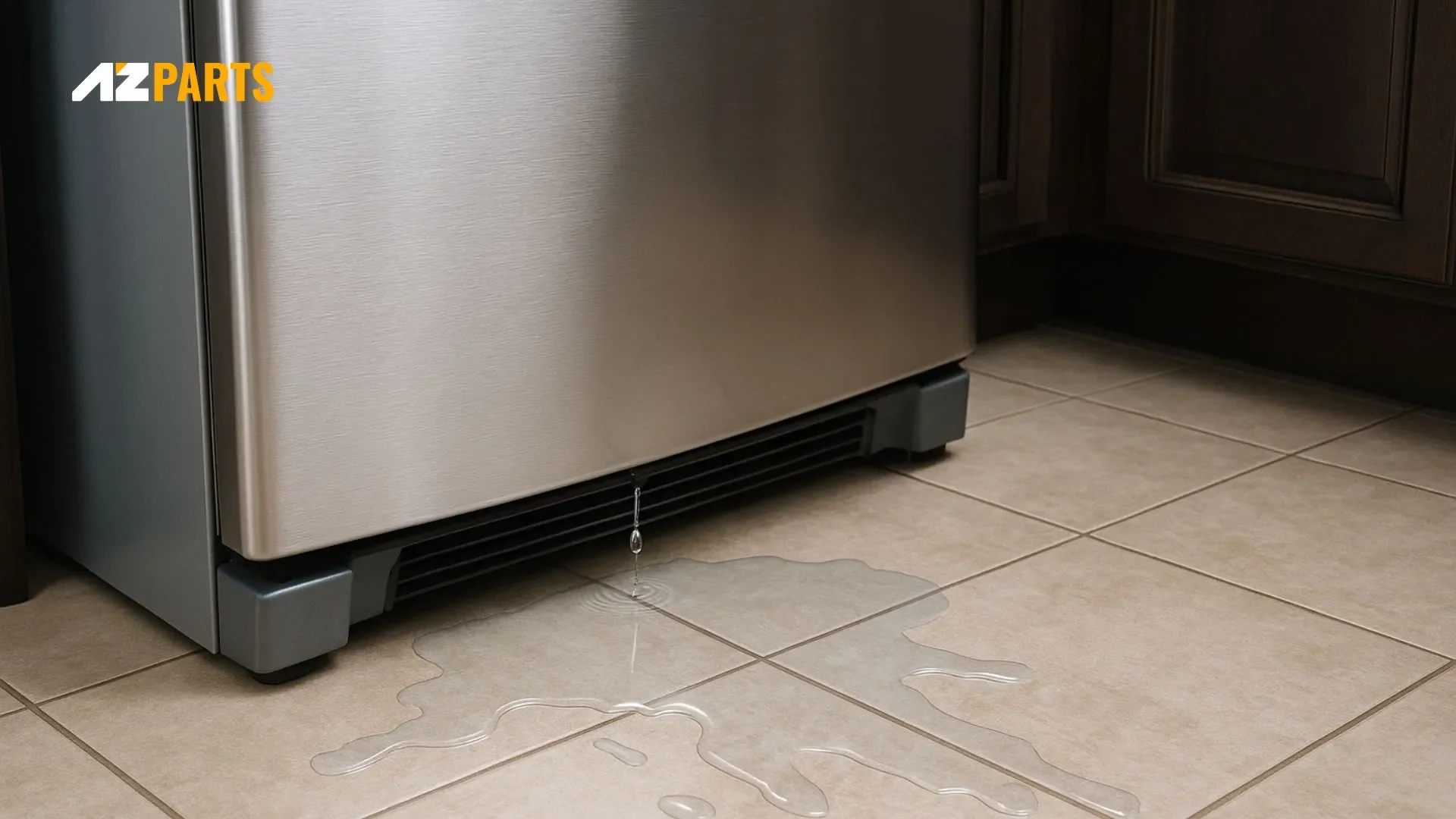
How to fix:
- Flush the defrost drain using warm water or a pipe cleaner to remove blockages. A clogged defrost drain can cause water to back up and pool inside the fridge or beneath it. Locate the drain hole (usually behind the back panel) and flush it with warm water. Use a pipe cleaner or turkey baster to clear any debris.
- Secure the water line connections and inspect for cracks or damage. Check the water supply line behind the fridge for loose fittings, cracks, or pinholes. Tighten connections and replace damaged tubing to prevent leaks at the back or underneath the unit.
- Remove and reinstall the water filter properly. Replace if damaged. An improperly seated or damaged water filter can cause water to leak inside the fridge. Remove the filter, inspect the housing and O-rings, then reinstall it securely. Replace it if you notice any signs of wear or cracks.
- Clean or replace door gaskets to ensure tight sealing. If the door doesn’t seal tightly, warm air enters and creates excess condensation, which can drip and collect as water. Wipe the gaskets clean with warm, soapy water, and if they’re cracked or deformed, install new ones for a proper seal.
8. Whirlpool Refrigerator Door Not Closing
Why It Happens
- Blocked by items inside: Large containers or improperly placed items can obstruct the door.
- Misaligned or loose hinges: Hinges may sag or shift over time.
- Worn door gasket: Cracked, dirty, or deformed gaskets prevent a proper seal.
- Fridge not level: If tilted forward or sideways, doors may not swing closed.
How to fix:
- Rearrange contents to prevent obstruction: Remove or reposition large containers, trays, or bottles that may be blocking the door from closing completely. Ensure shelves are not overloaded and nothing is sticking out.
- Tighten or realign door hinges: Use a screwdriver to check if the hinges are loose. If the door sags or misaligns, adjust the hinges so the door sits evenly and seals properly.
- Clean or replace the gasket: Wipe the door gasket (rubber seal) with warm, soapy water to remove debris or sticky residue. If the gasket is cracked, torn, or deformed, replace it to restore a proper seal.
- Adjust the fridge’s front leveling feet: Tilt the refrigerator slightly backward by adjusting the front leveling legs. This helps the door swing shut more naturally and stay closed.
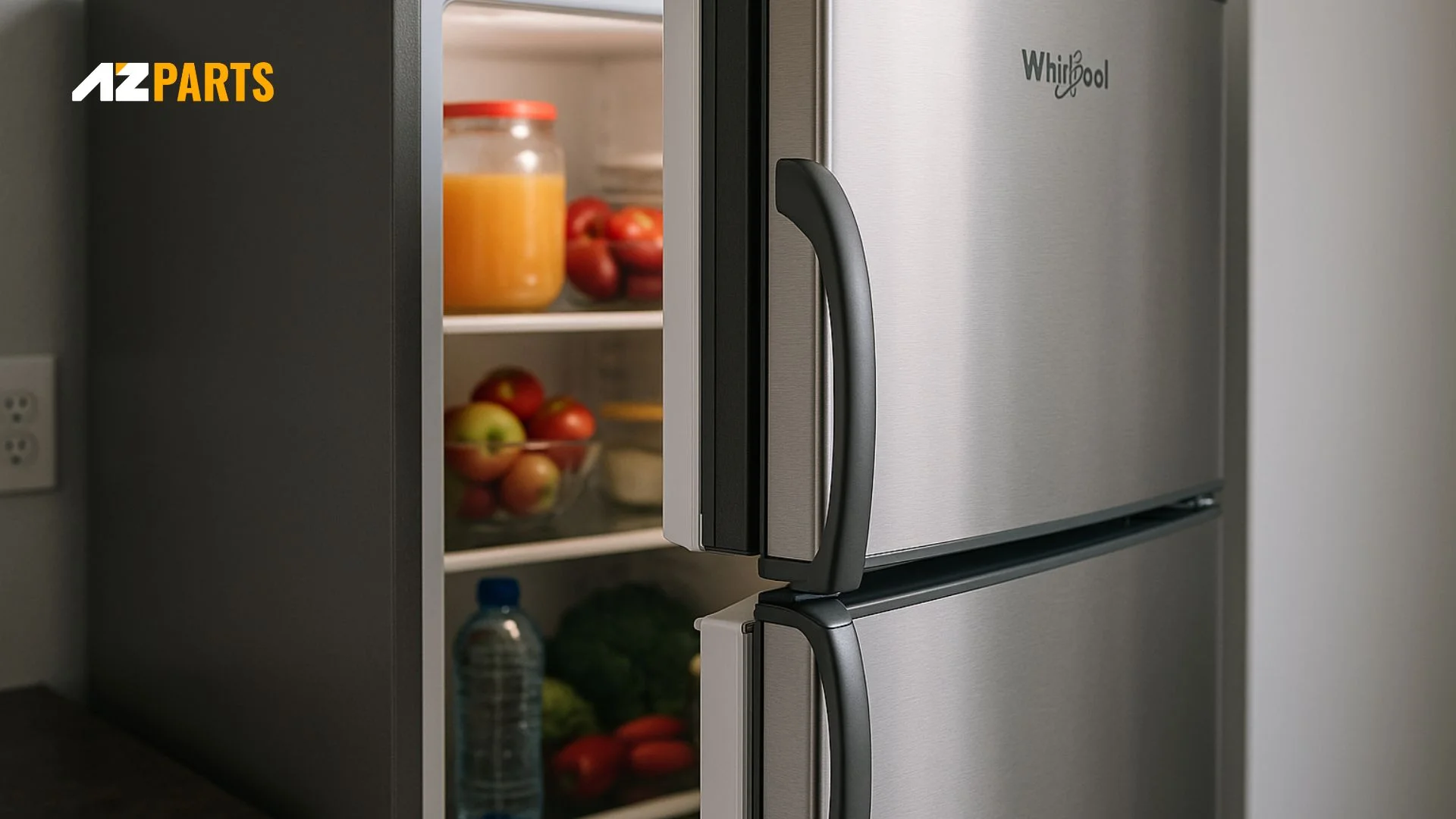
Whirlpool fridge door fails to shut completely (Source: AZParts)
9. Whirlpool Refrigerator Runs Constantly
Why It Happens
- Dirty condenser coils: Dust prevents heat from dissipating.
- Worn door seals: Leaky gaskets let warm air in.
- Incorrect temperature settings: May cause the compressor to overwork.
- Frequent door openings: Constant warm air intake prolongs cooling cycles.
- Faulty thermostat or control board: May fail to detect proper temperatures.
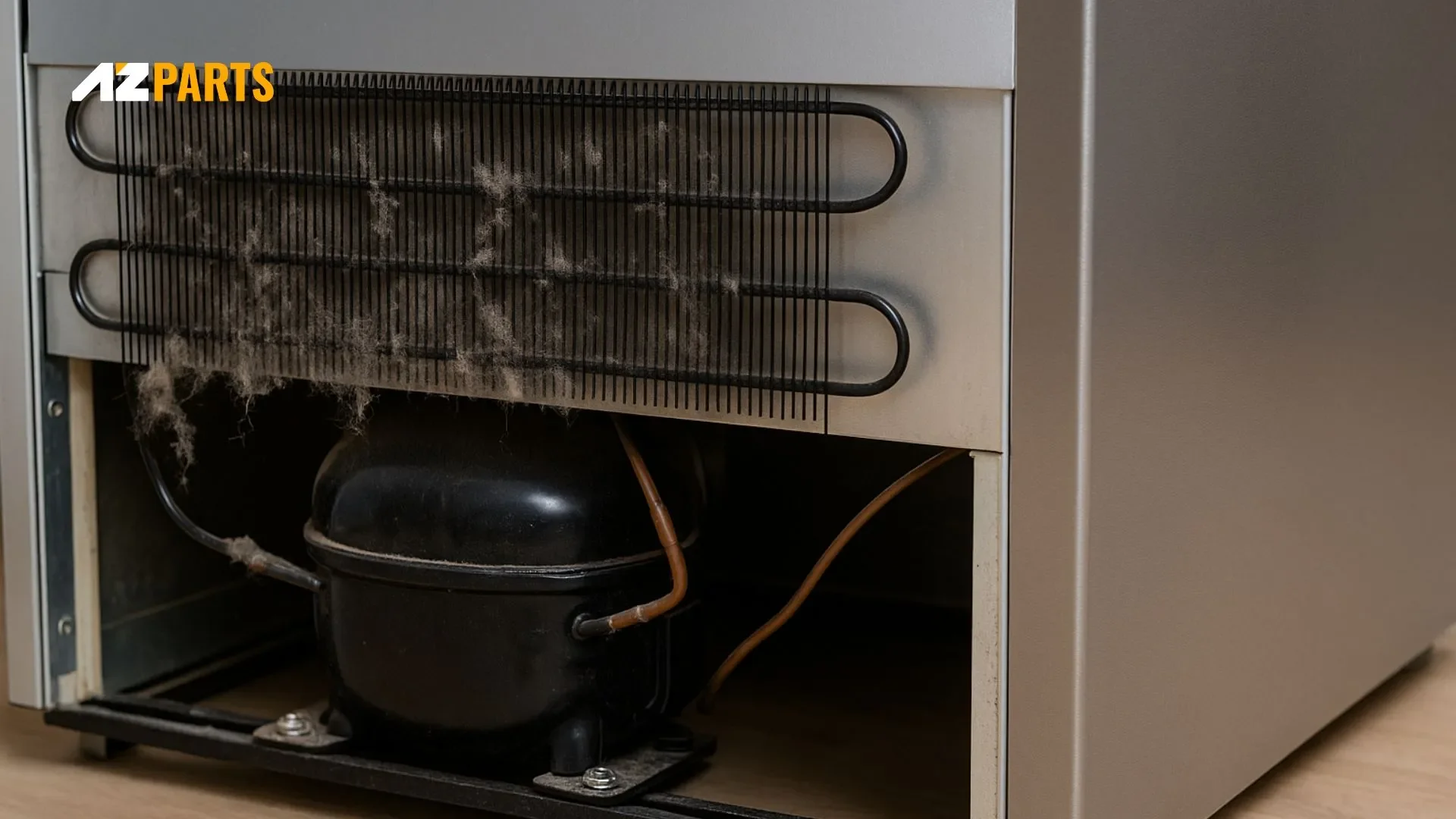
Dust-Covered Refrigerator Condenser Coils Causing Inefficient Cooling (Source: AZParts)
How to fix:
- Clean the condenser coils using a vacuum or coil brush: Unplug the refrigerator and locate the coils (usually behind or beneath the unit). Gently remove dust and debris using a coil brush or vacuum cleaner. Clean coils help the fridge release heat efficiently, reducing compressor overuse.
- Replace damaged door gaskets: Inspect the rubber seals around the doors for cracks, warping, or looseness. A faulty gasket lets warm air in, forcing the fridge to work harder. If cleaning doesn’t help, install new gaskets to restore a proper seal.
- Set fridge to 37–40°F and freezer to 0°F: Use a thermometer to check internal temperatures. If settings are too low, the unit will overwork. Adjust the temperature controls to the recommended range for optimal cooling without excessive cycling.
- Limit how often and how long you open the doors: Avoid frequent or prolonged door openings, as they let warm air in and force the compressor to run more. Plan ahead to minimize door use during meal prep or grocery storage.
- If none of the above helps, test or replace the thermostat and check the main control board. A faulty thermostat may not detect temperature correctly, causing the compressor to run nonstop. Similarly, a malfunctioning control board can send incorrect signals. If the issue persists, contact a technician to diagnose and replace these components if needed.
10. Whirlpool Refrigerator Smells Bad
Why It Happens
- Spoiled food or spills: Leftover odors linger after food goes bad.
- Bacteria or mold: Hidden moisture leads to microbial growth.
- Dirty drip pan: Accumulates stagnant water and grime.
- Power outages allow food to spoil unnoticed.
How to fix:
- Remove all contents and clean with a baking soda or vinegar solution. Take out all food and shelves, then wipe down the interior walls, drawers, and shelves using a solution of baking soda and water or diluted white vinegar. This helps eliminate bacteria and odor-causing residue.
- Discard expired items: Check all stored food for expiration dates or spoilage. Throw away anything that smells off, looks moldy, or is past its prime to prevent lingering odors from returning.
- Rinse the drip pan under the unit: Locate the drip pan (usually behind the front grille or at the back). Carefully remove it and rinse it with warm, soapy water to clear out mold, mildew, or standing water that may be causing bad smells.
- Leave an open box of baking soda inside to neutralize odors: After cleaning, place an open box of baking soda on a shelf in both the fridge and freezer compartments. It will help absorb remaining odors and keep the interior smelling fresh over time.
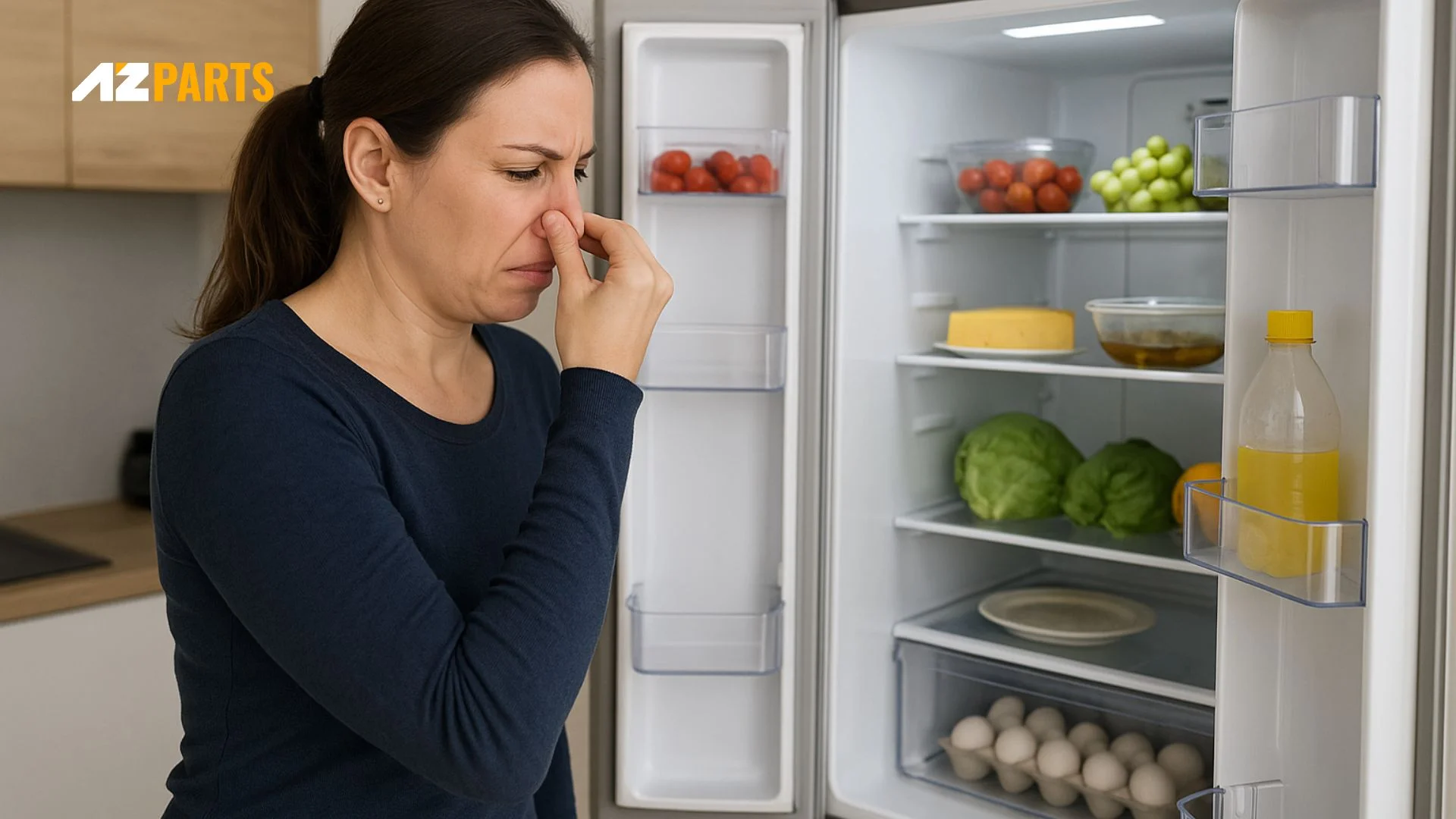
Unpleasant Smell Inside the Whirlpool Refrigerator (Source: AZParts)
11. Whirlpool Refrigerator Not Making Ice
Why It Happens
- Clogged water filter: Restricts water flow to the ice maker.
- Frozen or kinked water line: Stops water delivery.
- Faulty water inlet valve: Prevents water from reaching the tray.
- Broken ice maker unit: Mechanical failure halts operation.
- High freezer temperature: Prevents ice formation.
How to fix:
- Replace the water filter if it is over six months old: A clogged or expired filter can restrict water flow to the ice maker. Replace it with a compatible filter model, especially if it’s been more than six months since the last change.
- Check and thaw the water supply line: Inspect the water line at the back of the fridge. If it’s frozen, unplug the unit and use a hairdryer or warm towel to thaw the line carefully. Ensure there are no kinks or blockages.
- Test the inlet valve for function and replace if needed: The inlet valve controls water flow into the ice maker. If it’s faulty or has weak water pressure, it may need replacing. Use a multimeter to check continuity, or consult a technician for diagnosis.
- Inspect the ice maker mechanism for jams or defects: Open the ice compartment and look for stuck ice cubes or broken parts. Remove any blockages and reset the ice maker if needed. If parts are damaged or the motor fails to cycle, replacement may be necessary.
- Ensure the freezer is at 0°F (-18°C) or colder: Ice production slows or stops if the freezer is too warm. Check the temperature setting and adjust it to 0°F. Also, avoid overloading the freezer, which can restrict airflow and affect cooling efficiency.
Experiencing problems with your Whirlpool refrigerator can be frustrating, but many common issues—like cooling problems, water dispenser failures, or unusual noises—have simple, at-home solutions. Understanding the causes allows you to act quickly and avoid costly repairs.
To support your repair or maintenance needs, AZParts offers a wide selection of Whirlpool parts—from essentials like the Whirlpool refrigerator parts, Whirlpool Refrigerator Air Filter and Whirlpool Refrigerator Water Filter Cap to many other components that help restore your fridge’s performance. Whether you're replacing a worn-out part or upgrading your filter system, AZParts provides high-quality Whirlpool parts to keep your refrigerator running efficiently.
With fast shipping and trusted support, AZParts makes finding the right Whirlpool parts easier than ever.
Contact Information:
8 The Green, Ste A, Dover, Delaware 19901-3618, United States
Learn more about other common issues your refrigerator might encounter:
Refrigerator
- 1. Whirlpool Refrigerator Not Cooling Properly
- 2. Whirlpool Refrigerator Water Dispenser Not Working
- 3. Whirlpool Refrigerator Not Defrosting
- 4. Fridge Making Loud Noise
- 5. Whirlpool Refrigerator Error Codes
- 6. Whirlpool Refrigerator Light Flickering
- 7. Whirlpool Refrigerator Leaking Water
- 8. Whirlpool Refrigerator Door Not Closing
- 9. Whirlpool Refrigerator Runs Constantly
- 10. Whirlpool Refrigerator Smells Bad
- 11. Whirlpool Refrigerator Not Making Ice
Further Reading
Further Reading

